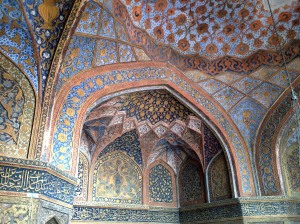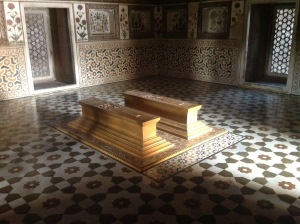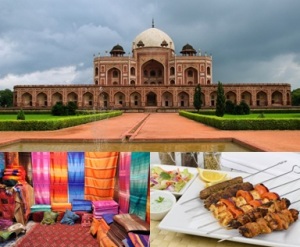Connect with us Visit Us Facebook Flickr Twitter
Visiting Agra
Agra is the former capital of Hindustan (India). It is a city on the banks of the river Yamuna in the state of Uttar Pradesh. Though Agra’s history is largely recognized with Mughal Empire, the place was established much before that and has linkages since Mahabharata period and Maharishi Angira in 1000 BC. It is generally accepted that Sultan Sikandar Lodi, the Ruler of the Delhi Sultanate founded Agra in the year 1504. After the Sultan’s death, the city passed on to his son Sultan Ibrahim Lodi. He ruled his Sultanate from Agra until he fell fighting to Babar (who became the first Mughal Emperor) in the first battle of Panipat in 1526. The golden age of the city began with the Mughal rule. It was known then as Akbarabad (after the Mughal Emperor Akbar) and remained the capital of the Mughal Empire under the Emperors Akbar, Jahangir and Shah Jahan. Shah Jahan later shifted his capital to Shahjahanabad (now old Delhi) in the year 1649.
The famous Mughal emperor Akbar raised the towering ramparts of the Great Fort, besides making Agra a center for learning, arts, commerce and religion. Akbar also built a new city on the outskirts of Akbarabad called Fatehpur Sikri. This city was built in the form of a Mughal military camp in stone. His son Jahangir had a love of gardens and flora and fauna, and laid many gardens inside the Agra Fort. Shah Jahan, known for his keen interest in architecture, gave Akbarabad its most prized monument, the Taj Mahal. Built in loving memory of his wife Mumtaz Mahal, the mausoleum was completed in totality in 1653. Shah Jahan later shifted the capital to Delhi during his reign, but his son Aurangzeb moved the capital back to Akbarabad, usurping his father and imprisoning him in the Fort there.
The sight of a white marble mausoleum, raised on a platform and graced by 4 minarets on each corner, reflected in the watercourse that runs through the ornamental gardens is an unrivaled tourist attraction in Agra. Taj Mahal, a symbol of undying love, has been summed up by Ghalib, the famous Urdu poet, as a rebuff of an ordinary man’s love for his beloved, in whose memory he cannot build a monument of such magnificence. Today, Taj Mahal is a major tourist attraction in Agra, and is open to all even on full moon nights, so that you can take your beloved by the hand and walk down the gardens as moon and its entourage of stars light your path on your tour to Agra. Besides Taj Mahal, there are plenty of tourist attractions in Agra that will keep your hands full while in Agra.
Sightseeing, Shopping and Eating in Agra — Suggestions and Options
Go sightseeing in Agra. Visit Fatehpur Sikri, which was the political capital of India’s Mughal Empire under Akbar’s reign from 1571 till 1585 and regarded as the crowning glory of his architectural legacy. Taj Mahal is a perfectly symmetrical monument that took 22 years (1631–1652) of labor and 20,000 workers, masons and jewelers to build, and is set amidst the landscaped gardens. Built by the Persian architect, the Taj Mahal is on the south bank of the Yamuna River. It can be observed from Agra Fort from where Emperor Shah Jahan gazed at it for the last eight years of his life, as a prisoner of his son Aurangzeb. It is an acknowledged masterpiece of symmetry. Verses of the Koran are inscribed on it and at the top of the gate are twenty-two small domes, signifying the number of years the monument took to build. Enjoy the Saga of the Taj at Kalakriti Cultural and Convention Centre, a series of play depicting the immortal love of Shajahan for Mumtaj Mahal- his beautiful wife, the lavish lifestyle of Mughal era and emaculate hardship of the artisans for 22 years that created the most precious specimen of craftsmanship.
Submerge in the majestic views of Agra fort, a UNESCO World Heritage site located in Agra, India. The fort is also known as Lal Qila, or Red Fort of Agra. It is about 2.5 km northwest of its much more famous sister monument, the Taj Mahal. The fort can be more accurately described as a walled palatial city. The fort contains splendid palaces both in red sandstone and white marble built by two generations of prolific builders Akbar and later Jehangir and Shahjahan. Some of the exquisite structures that deserve a mention are:
- Sheesh Mahal – Literally meaning ‘Glass Palace’, was the royal dressing room adorned by tiny mirror-like glass-mosaic decorations on the walls.
- Diwan-i-Am – It was used as a communications ground between the public and the aristocracy and once housed the Peacock Throne.
- Diwan-i-Khas – A hall of private audience, it was used to welcome kings and dignitaries.
- The Anguri Bagh – It houses 85 square, geometrically arranged lush gardens.
- Khas Mahal – An immaculate white marble palace.
- Mina Masjid – Literally meaning ‘Heavenly Mosque’, it is a tiny mosque closed to the public.
- Nagina Masjid – Literally meaning ‘Gem Mosque’, it was designed exclusively for the ladies of the court.
- Musamman Burj – A large, octagonal tower with a balcony facing the Taj Mahal.
Proceed on a tour of Sikandra. Akbar’s tomb in Sikandra is an exquisite example of different styles of architecture. This tomb signifies the characteristic flavor of the styles and architecture used in Agra Fort and Fatehpur Sikri. Visit Itmad-ud-Daulah’s tomb, which is a highly ornate structure, which is looked upon as a precursor of the Taj Mahal as far as intricate carvings and inlay work are concerned. Itmad-ud daulah contains cenotaphs of Mirza Ghiyas and Asmat Begum, parents of the powerful Mughal Empress Noor Jehan, Queen of Jahangir, an exceptional beauty and an astute administrator.
Coming to exploring the deeper parts of the Agra city; one can feel the lingering presence of the bygone years and charm of the rulers, emperors & kings who once adorned the city, to their own desires. The Mehtab Bagh or Moonlight Garden is on the opposite bank of the River Yamuna from the Taj Mahal.
Other sights worth seeing in the Agra include:
- Mariam’s Tomb
- Ram Bagh
- Dayal Bagh
- Soami Bagh
- Old Chungi, the library
- Mankameshwar Temple
- Jama Masjid
- Johri Bazar
- Kala Mahal (Mirza Ghalib’s birthplace)
Shopping experience in Agra is mostly remembered as visiting the lanes of different local bazaars filled with an array of handicraft & handloom articles, and spotting that mini Taj replica in various sizes at every corner of the bazaar. Leather items at Agra are famous for their quality. These include leather sandals, purses, bags and decorative items. There are lots of handicraft emporiums that offer a variety of sandalwood and rose wood items along with brass decorative pieces and stone carved images. The fine work done by the local artisans in the city is notable and the markets of Agra are the best place to explore exquisite pieces of fine Zari embroidery work, stone inlay work and precious gemstones. One can find most of the big emporiums concentrated in the area not far from Taj Mahal. Yet, those of you who can steer through the narrow lanes of the city markets of Kinari Bazaar, Raja Mandi, Fuhaara and Lohamandi can get their hands on the best bargains.
For an unforgettable shopping experience:
- Kohinoor – jewels and embroidery emporium
- Marble art palace – demonstration of marble inlay work
- Shilpagram, a craft village on the eastern side of Taj Mahal in Agra, is a popular open-air emporium
- Sadar Bazaar
- Kinari Bazaar
- Raja Mandi
Eating out in Agra is an unforgettable experience that can take you back to the bygone era of mughlai food and dining, where spices, essence and hospitality come together to create the magic, right in your plate! Several of India’s famous meat dishes come from the north where Mughal influence introduced considerable sophistication. The superb Mughlai cuisine with its luscious sauces of milk, curd, cream and crushed nuts is a hit in major restaurants of this city. There is rich, creamy kormas; tender steak like pasandas in an almond sauce; nargisi kofta; an array of kebabs; dalmoth; petha and more.
Esphahan, located in the plush Oberoi Amarvilas, will have you feeling like an emperor after eating one of their extraordinary meals. Inspiring Awadhi fare, traditionally from Lucknow, is recreated here with outstanding aplomb. Enjoy the live classical Indian music and exceptional service while you work your way around one of their Thali (plate) — it’s the best way to taste as many of Esphahan’s delectable dishes as possible.
Taj Khema is in the proximity of the Taj Mahal and offers a great view of the Taj Mahal. In Hotel Taj Khema, the guests can choose from a wide range of Indian and continental delicacies. Relax and enjoy the scrumptious food here, overlooking the Taj Mahal in all its pristine glory. Along with food you are also entertained with beautiful Indian folk music and cultural shows with a new theme every month.
At the Only Restaurant, bamboo-lined walls and red tablecloths set the scene and attentive staff serves up a big range of vegetarian and non-vegetarian dishes in styles such as Mughlai, Afghan, Chinese and Continental. Do not miss the Maharaja Thali here, showcasing a traditional meal – good variety and taste.
Visit Pinch of Spice for a quick buffet or an Indian meal. Quick service accompanied by generous portions of good food with typical spices, kormas, and tikkas.
Some Boutique hotels in close proximity to the Taj Mahal provide amazing rooftop restaurants where you can enjoy a sundowner cocktail with scrumptious kebabs of Mughlai cuisine, with Taj as a backdrop.
Visit us at http://www.iteg.in/ or http://pinkescapes.in/ or http://www.amaltasluxury.in/ to book a tour and exciting experiences.



